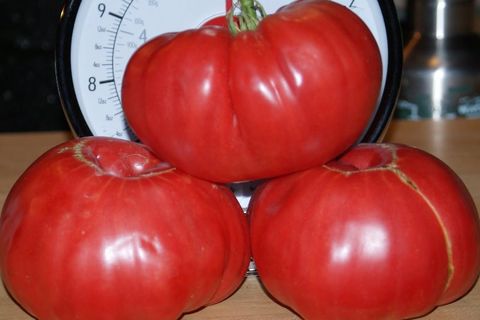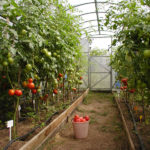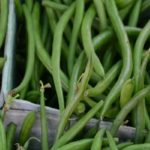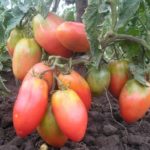Tomato Stopudovy and tomato One Hundred Poods have similar names, but they are different tomatoes. Each has its own characteristics and description of the variety. Both are large-fruited and productive, but the mention of an ancient measure of weight in their names is a poetic exaggeration, a hyperbole. The weight of a pood by modern standards is just over 16 kg. But the name is memorable, sounds impressive and beautiful.
Option from “Ural Summer Resident”
Relatively recently, the Stopudovy tomato from the Mars agricultural company went on sale. This new product is produced in packages labeled “Ural Summer Resident” as part of the “Siberian Series” project. It is not by chance that Siberia is mentioned.This emphasizes the unpretentiousness of the variety. The tomato is capable of growing and successfully bearing fruit in any region of the country, because it is intended for closed ground. The variety is not included in the State Seed Register.
The bushes are indeterminate, with unlimited growth. They require reliable staking of stems and brushes, regular pinching, and removal of the growing point at the end of the season. They need increased nutrition and regular watering, protection from diseases. With high agricultural technology, it is possible to get a bucketful harvest from one bush. This is the potential yield to which we must strive.
Stopudovy is a tomato with a record weight of fruit: 500 and even 700 grams is far from the limit. If only one strong ovary is left on the first brush, then it can grow to gigantic sizes - 1 kg 200 grams. This is, of course, not a penny, but very impressive.
The fruits are round, flattened on top and bottom, slightly ribbed. The color is rich, bright red. The pulp is sugary, moderately watery. Ripe tomatoes are not stored for a long time: they go into fresh salads and are excellent for processing into juice.
Alternative from "Aelita"
The tomato variety One Hundred Poods was created specifically for the Aelita agricultural company by an experienced team of scientists: V. G. Kachainik, N. V. Nastenko, O. V. Astakhova. The breeding novelty received a patent and registration number in the State Seed Registry in 2013.
Recommended for open and closed ground in all regions of Russia suitable for agriculture. Reviews from amateur vegetable growers indicate that the One Hundred Poods tomato is also popular in the Near Abroad.
Original fruits
The Hundred Poods tomato is remembered for the fantastic shape of its fruits.Most of all, a tomato resembles a knapsack tied with a string. Accordion-shaped folds are formed on top. The general shape is similar to a pot-bellied pear - sometimes elongated, sometimes slightly flattened at the bottom.
There are certain similarities with Truffle tomatoes (“Light bulbs”), but they are smaller in size and the ribbing is not so pronounced.
The Hundred Poods variety is closer to the large-fruited category: the first or second cluster contains fruits weighing 250 - 300 grams. The average weight of tomatoes of this variety is 230 grams, the minimum (in the upper clusters) is 150 grams. Such “pears” are already suitable for whole-fruit pickling, although the general purpose of the variety is for salads and decorating dishes by cutting them crosswise. The color of the surface and pulp is very bright, a classic red hue.
The skin is thin and durable, easily removed even without blanching. Quite dense - it does not crack, provides good transportability and quite decent shelf life for a large variety. There are few seeds in the fruits. They can be left for planting next season, because the Hundred Poods variety is not a hybrid. The pulp is without voids, medium in density, not watery. A high percentage of dry matter was noted.
Both the authors of the variety and summer residents praise the fragrant fruits for their excellent taste., very rich, truly sweet. The acid is almost not felt.
Tomatoes of the Hundred Poods variety resemble in appearance another variety, Puzata Khata (also from the Aelita company): the same pear-shaped shape with an “accordion” near the stalk. But Puzataya Khata has slightly smaller fruits and an earlier ripening period. Reviews from summer residents about the quality of the pulp give preference to the Hundred Poods variety as more meaty and filling, less loose.Probably, the early ripening Puzata Khata variety does not have time to fully bear fruit.
tall bushes
In open-air ridges, the bushes of the Hundred Poods variety rise to a height of one and a half meters. To grow this tomato in the ground, high stakes or a trellis are required.
In greenhouses, indeterminate stems often reach the ceiling. Without shaping, the plants quickly thicken, the fruits become smaller, and the overall yield decreases.
Harvesting
According to the ripening period, the tomato variety One Hundred Poods is included in the mid-season category. In open ground it does not turn red in all regions, but it ripens successfully and quickly when lying down. In a greenhouse, the first ripe fruits can be harvested 110 days after germination, two months after planting the seedlings in a permanent place.
The harvest from tall bushes continues until the very end of the season.
Medium-sized foliage does not shade fruit branches. The inflorescences have an intermediate shape between a simple and complex raceme. Often they bear 6–7 flowers, but, as a rule, 4–5 fruits are set. If the owner wants to grow heavier tomatoes, it is recommended to normalize the bunches at an early stage of their development (the top buds are plucked out so that only 3 to 4 flowers bloom).
The standard yield of the Hundred Poods variety, declared in the State Register, is 8–9 kg per square meter of planting. Vegetable growers-enthusiasts remove 6 - 7 kg from one bush. Of course, this is only possible in a greenhouse or open ground in the southern regions. Record harvests are achieved due to the high growth of bushes and a long period of their development.
Not being a hybrid, the Hundred Poods tomato can suffer from fungal and viral infections, especially in the absence of crop rotation and protective measures.
Features of agricultural technology
The Hundred Poods tomato is not overly capricious, but needs careful care, like any intensive type variety - tall and productive:
- Seeds are sown 60 days before the planned planting in a greenhouse or outdoor bed.
- Seedlings tend to stretch and suffer from heat and lack of light.
- The planting density in the greenhouse is 3 roots per square meter, outdoors - 4 roots per similar area.
- The soil must be mulched.
- Fertilizing is carried out once every two weeks, watering is carried out weekly. The variety is responsive to root and foliar feeding with microelements.
- It is mandatory to carry out preventive and therapeutic measures against harmful infections.
- The greenhouse should not be too damp and hot. It is necessary to establish through ventilation, otherwise flowers and ovaries will fall off and diseases will develop.
- The variety Hundred Poods is grown in one or two stems, regularly removing all the stepsons.
Tomato One hundred pounds is still a novelty for most gardeners. Many are yet to become acquainted with its original fruits.
















